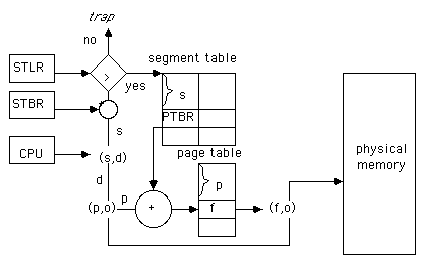This shows the function used to map a logical address to a physical address for schemes combining paging and segmentation. Throughout this handout, page_size is the size of the page (which is a multiple of 2), seg_tbl_base_reg contains the address of the base of the segment table, and memory is the main store of the computer. We will assume the entire program is in memory, so no error handling is given; were this assumption false, the situation where the requested address were not in memory would need to be handled (by generating a fault and loading the appropriate data structure).
In this algorithm, the page tables are segmented. The virtual address is represented as a pair (logical_page, offset), but the logical_page consists of a pair (seg_number, seg_offset) indicating which segment number seg_number of the page table the frame number frame_no is stored in, and the offset seg_offset from the base of that segment table. As usual, an associative memory is first checked; this will be represented by the function assoc_page_table, which returns the frame number if that is in the table, and -1 if not:
function NL_map((logical_page, offset)): physical_address;
var frame_no: integer; (* number of frame *)
pg_tbl_base: integer; (* addr. of page table segment *)
begin
frame_no := assoc_page_table(logical_page);
if frame_no = -1 then begin
pg_tbl_base := memory[seg_tbl_base_reg + seg_number];
frame_no := memory[pg_tbl_base + seg_offset];
end;
NL_map := frame_no * page_size * offset;
end (* NL_map *)
In this algorithm, the segments are paged. The virtual address is represented as a pair (seg_number, offset), but the offset consists of a pair (page_number, page_offset), indicating which page number page_number of the segment seg_number the frame number frame_no is stored in, and the offset page_offset from the base of that page. As usual, an associative memory is first checked; this will be represented by the funcetion assoc_page_table, which returns the frame number if that is in the table, and -1 if not. Note it takes the segment number as an argument as well:
function NL_map((seg_number, offset)): physical_address;
var frame_no: integer; (* number of frame *)
pg_tbl_base: integer; (* addr. of page table segment *)
begin
frame_no := assoc_page_table(seg_number, page_number);
if frame_no = -1 then begin
pg_tbl_base := memory[seg_tbl_base_reg + seg_number];
frame_no := memory[pg_tbl_base + page_number];
end;
NL_map := frame_no * page_size * page_offset;
end (* NL_map *)
In pictures:
| You can also obtain a PDF version of this. | Version of April 30, 2008 at 4:02 PM |